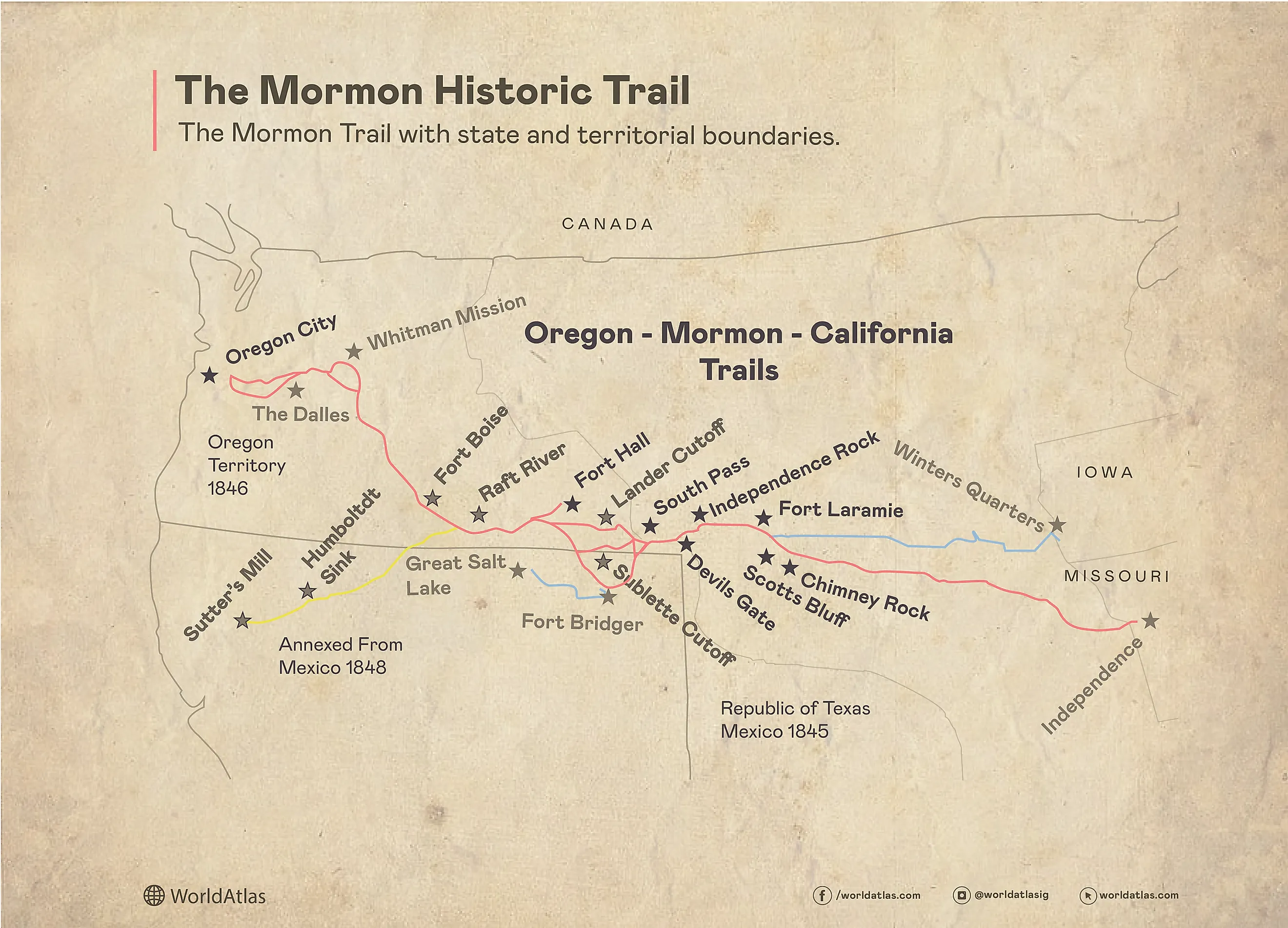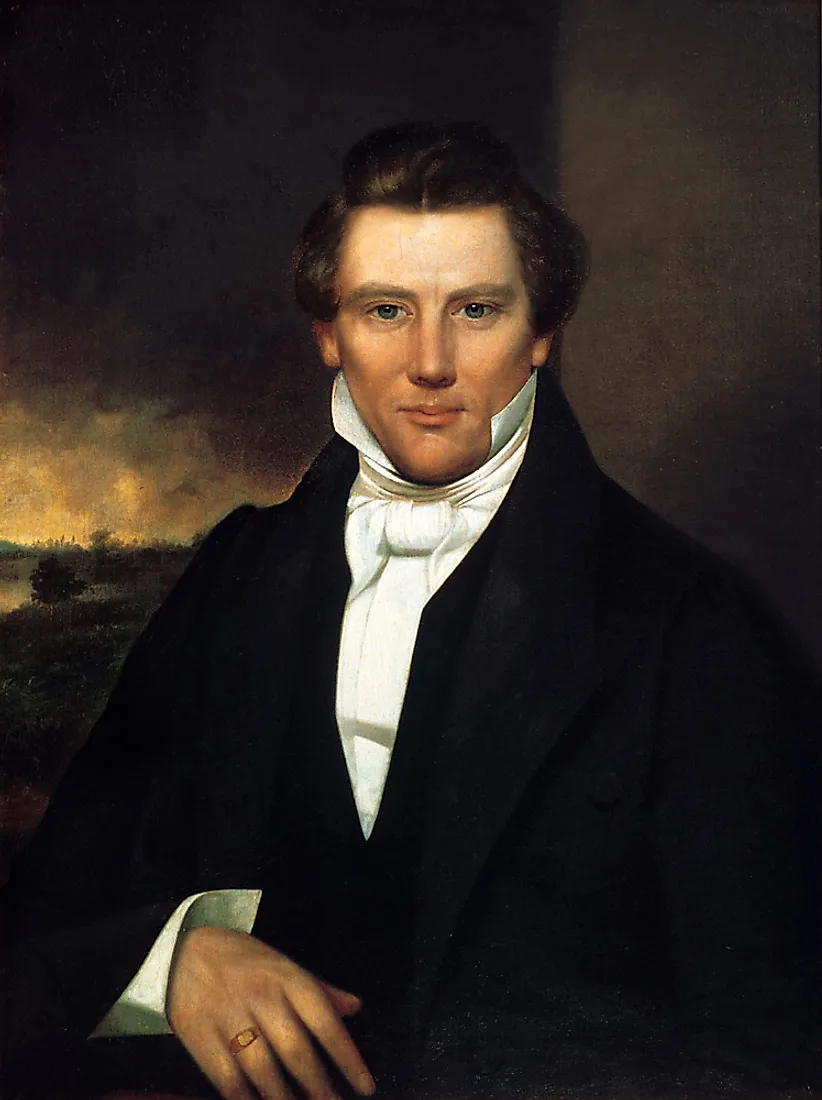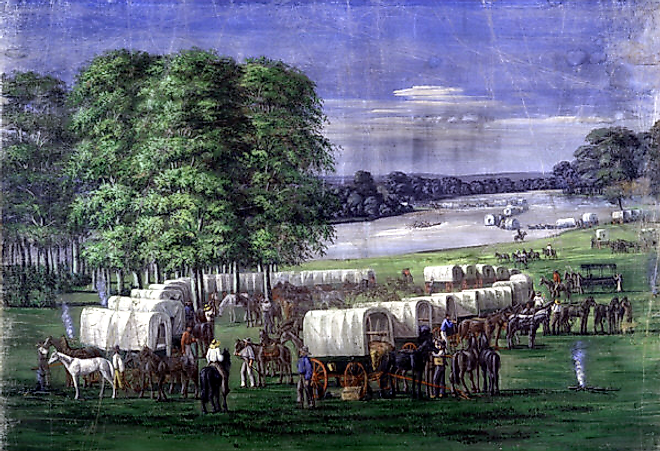
Mormon Trail
The Mormon Trail was a 1,300-mile trail beginning at Nouvoo, Illinois and ending in Salt Lake City, Utah. Fighting for their right to religious freedom, a group of almost 3,000 Mormons, led by Brigham Young, traversed the trail in the winter of 1846 to reach their new holy land in Utah. This group of about 500 wagons and handcarts drawn caravan paved the way for more than 60,000-70,000 others who later used the Mormon Trail to Utah until the arrival of the railroad.
Origins of the Mormon Faith

The Mormon story begins in 1827 when a young man named Joseph Smith claimed to have been visited by an angel named Moroni, who showed him a set of golden plates with holy inscriptions for the true church. By 1830, Smith had established The Church of Jesus Christ of Latter-day Saints with its own holy scriptures called the Book of Mormon. Adherents of this new American religion became known as Mormons.
Bad politics, land and business deals, and the stark differences between Christianity and Mormonism created major problems for the Mormons. Smith relocated his church several times until they finally settled down in Illinois. They established a settlement and called it Nauvoo. But differences again began to creep up between the Mormons and surrounding neighbors. The practice of polygamy within the church leadership political and questionable business practices set things off between the Mormons and their neighbors.
By 1844, Smith had been arrested and murdered by an angry mob. He was replaced by Brigham Young who organized the relocation of almost 15,000 Mormons to the Great Basin area to escape persecution.
The Vanguard Journey to Utah

Pioneers Crossing the Plains of Nebraska
On February 4, 1846, a small group of Mormons known as the first Pioneer Company (also called the Vanguard Company) left Nauvoo, crossed the Mississippi River, and landed in Iowa. They were bombarded with heavy rainfall, which made for poor traveling conditions. They finally arrived in Iowa and set up camp at Sugar Creek, waiting for their leader’s arrival. By the time of Young’s arrival, the camp had grown to double its original size. Finally, the group started their journey on March 1, 1846, towards the Missouri River, thus establishing the Mormon Trail.
By the time they arrived near the Missouri River on June 14th, the group had already missed the season to make it to the Great Basin on time. They decided to set camp for the winter and settled near the river in present-day Council Bluffs, Iowa. A few of them crossed the river and set up their Winter Quarters in Omaha, Nebraska.
The Arduous Overland Journey
The overland journey taken by the Mormons was arduous. They essentially followed the Oregon Trail that had been established in 1843. The group often came across other travelers who were heading west to Oregon. They also met Native Americans along the way, who were often friendly and helpful to the Mormons. To avoid competition for scarce resources such as fodder for the animals or water, the Mormons stayed on the northern side of the Platte River instead of taking the southern route typically taken by pioneers heading to Oregon. The last stretch of the Mormons' journey veered off Wyoming, and they left the Oregon Trail to follow Hastings Cutoff towards Salt Lake City.
Many Mormons came with their own wagons, and others used handcarts to travel. There were others who had neither form of transportation and took to the trail on foot. The journey was, at times, uneventful, but at other times, they struggled with a lack of supplies and food and had to combat all sorts of diseases, such as scurvy, dysentery, and mountain fever. Young himself became sick with mountain fever on the journey and had to stay back until he could recuperate before moving forward. He finally arrived in the area on July 24th and proclaimed that the land was “This is the right place, drive on.” July 24th is now celebrated as Pioneer Day in Utah.
Legacy of the Mormon Trail
Today, The Mormon Trail is registered as part of the United States National Trails Systems and is known as the Mormon Pioneer National Historic Trail. Salt Lake City is the headquarters for the Church of Christ Latter-day Saints. This is the Place Monument is considered the end of the historic Mormon Trail, which became the road less traveled with the arrival of the Transcontinental Railroad System.











